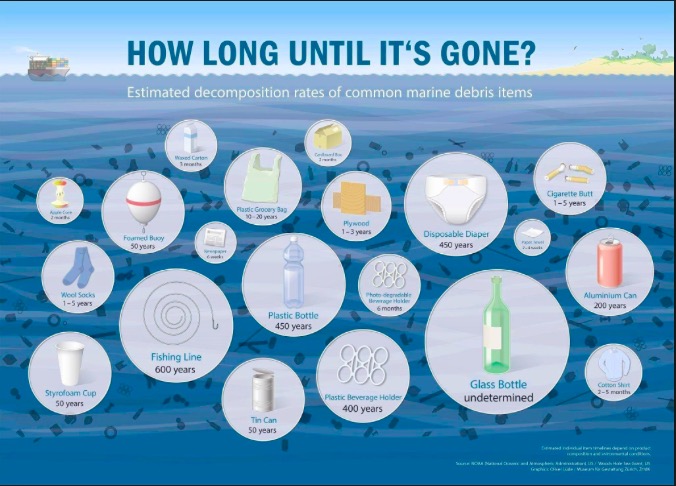Microplastic Pollution
Why it is dangerous and what we all can do to reduce it
Plastic is useful, convenient and ubiquitous. It is also a major pollutant that should be avoided. Which is much easier said than done. The idea of trying to go plastic-less has crossed my mind on numerous occasions but every time I realize within the time it takes me to open the plastic-wrapped Brie, squirt shampoo in my hand or put my sunglasses on that the idea might be a noble one – but the implementation is pretty darn near impossible.
There are many reasons why plastic is bad for the environment but in this article I want to focus on one: microplastic pollution and how everybody can reduce it by following some common sense and easy rules.
What Happens to Plastic We Discard?
Let’s focus on what happens to all the plastic that is left outside.
That banana peel carelessly left behind on the beach is yucky and a nuisance but eventually it will decompose. It can take up to two years, but then it will be gone. Plastic – not so much. If left outside and exposed to the elements plastic will sit around, and sit around, and sit around some more. Nobody really knows for how long. 500 years? 1000 years? Plastic has only been around for just over 100 years and in wide usage since the 1960s. Will our plastic still be around in the year 2500 or even at the turn of the next millennium? We don’t know.
What happens short-term to plastic left sitting outside is photodegradation, which is really just a fancy name for the plastic breaking down into smaller and smaller pieces. Sunlight and high temperatures – that is your typical beach conditions – speed up photodegradation. Eventually the pieces are too small to be seen which doesn’t mean they are gone, just that they are tiny and with that pose a new risk: blown all over by the wind these small plastic particles end up everywhere and are being ingested by animals. Again, we don’t really understand the extend of harm those tiny plastic particles do to animals that ingest them – more research is needed – but it seems rather intuitive that eating plastic is not a healthy thing. Internal damage from abrasion and digestive blockage are two health problems that are mentioned in the literature.
Another issue is that these small plastic particles can concentrate toxic pollutants in the ocean. Many of these pollutants, e.g. pesticides, dioxins and DDT are hydrophobic: like oil they don’t like to mix with water and when they encounter a hydrophobic surface, such as a plastic particle, they cling to it. Marine animals now not only ingest plastic, but plastic laced with some of the most toxic pollutants known to man.
But it isn’t only marine animals, humans are affected as well.
In 2017, some 83% of tap water samples collected from over a dozen countries on five continents tested positive for microplastics, according to a study commissioned by data journalism outlet Orb. The specific rate of prevalence in different locales varied, but all tested locations, from Europe to Jakarta and Beirut saw plastic found in over 70% of tap water samples.
The scale of this problem is enormous and it is easy to get discouraged in the face of it. But there are things we can do to help prevent plastic microparticle pollution of the environment, esp. the oceans.
Things We Can All Do Daily
The holy trinity of environmental protection for each individual is easy to remember:
Reduce
Reuse
Recycle
In that order. The best plastic waste is the one we don’t create.
Let’s focus on that
Ideas for getting started are easy to come by: googling “ways to reduce plastic waste” generated 66 million results in 1.09 seconds. Many of the tips you will read won’t come as a big surprise: don’t use plastic bags, don’t use plastic straws, buy things like detergent in cardboard boxes, not plastic bottles, pack your lunch in reusable containers and while you are at it, keep one tugged away in your purse for those restaurant leftovers. Then there are the cursed Styrofoam or plastic-lined to-go cups and plastic cutlery, in short, stuff that you simply should not use. There are perfectly affordable and lovely reusable mugs and spoons available.
There are also ways we can directly contribute to keeping microplastic out of the water. Let’s start with the obvious:
Pack it in, pack it out. If you can haul that bar, sandwich and juice box on a hike or to the beach, you can haul the containers out when they are empty and dispose of them properly. Not only will it keep nature cleaner, but you get less photodegraded plastic particles blowing every which way.
Don’t buy microparticle laced products. Some plastic particles are not the result of degradation but product features. Case in point: cosmetics like face washes or toothpaste that contain small beads for their abrasive properties. You can simply buy products without these beads or, if you really want beads, there are products containing biodegradable ones.
Don’t flush contact lenses but throw them in the trash. This one was new to me, too. Seems like such a minor thing, but the small, flexible contact lenses often aren’t caught in the filters designed to catch larger stuff people see fit to flush down the toilet or drain and end up on the bottom of lakes and oceans where some poor creature ends up eating them. With lots of people using daily contact lenses the problem is actually a large one.
Prefer natural fibers in your clothing. According to one study the largest portion of microplastics in the oceans come from our clothing. When we wash clothing made from synthetic fibers, small pieces slough off and end up in the oceans. These fibers are especially dangerous because they are long and thin and are even worse for animals that ingest them. Natural fibers are more pleasant to wear, but also they aren’t a source of microplastics.
If you need one more reason to walk more often: another major source of microplastic are plastic particles created from tire abrasion while driving. Add this to the other dozen or so reasons why you should leave the car in the garage whenever you can.
One last suggestion: participate in clean the beach/creek/park day to reduce the amount of plastic that can photo degrade into microplastic particles. Sure it can be exhausting but look at the bright side: it saves you the trip to the gym.
These suggestions might sound small and inconsequential but if millions of people do it, it adds up. And the more people set an example the more will follow – snowball effect!
The best thing is: you can start today!



